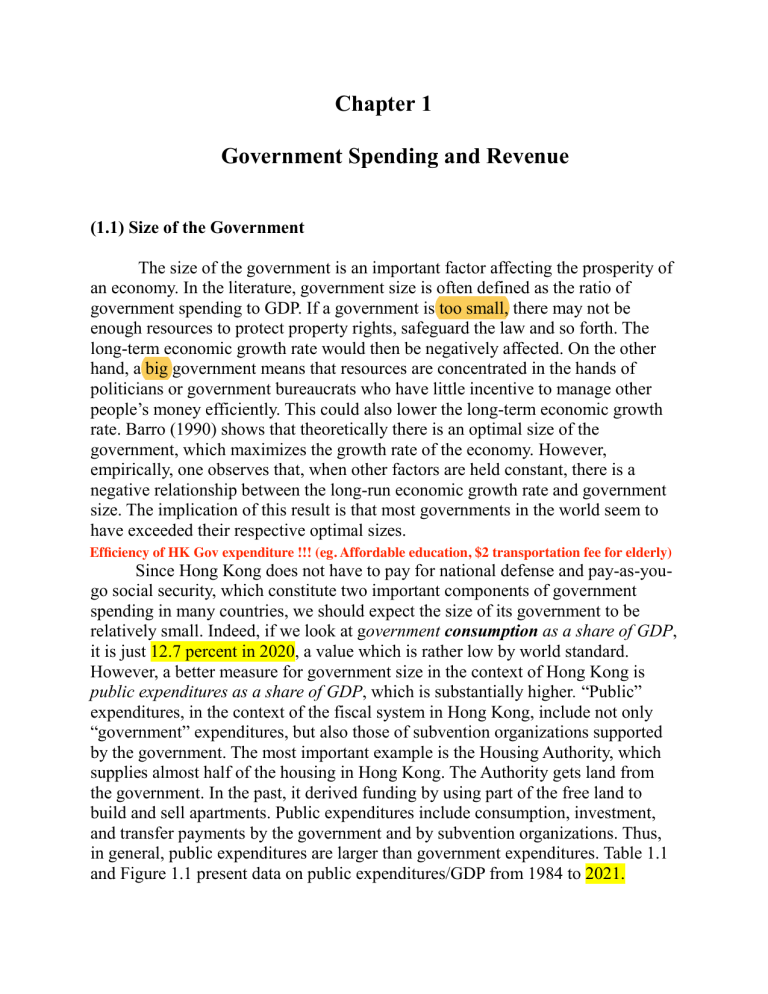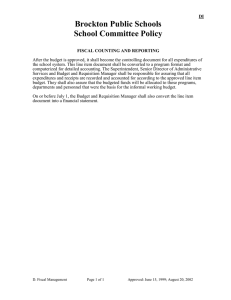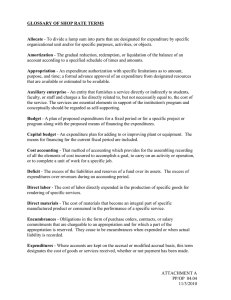
Chapter 1 Government Spending and Revenue (1.1) Size of the Government The size of the government is an important factor affecting the prosperity of an economy. In the literature, government size is often defined as the ratio of government spending to GDP. If a government is too small, there may not be enough resources to protect property rights, safeguard the law and so forth. The long-term economic growth rate would then be negatively affected. On the other hand, a big government means that resources are concentrated in the hands of politicians or government bureaucrats who have little incentive to manage other people’s money efficiently. This could also lower the long-term economic growth rate. Barro (1990) shows that theoretically there is an optimal size of the government, which maximizes the growth rate of the economy. However, empirically, one observes that, when other factors are held constant, there is a negative relationship between the long-run economic growth rate and government size. The implication of this result is that most governments in the world seem to have exceeded their respective optimal sizes. Efficiency of HK Gov expenditure !!! (eg. Affordable education, $2 transportation fee for elderly) Since Hong Kong does not have to pay for national defense and pay-as-yougo social security, which constitute two important components of government spending in many countries, we should expect the size of its government to be relatively small. Indeed, if we look at government consumption as a share of GDP, it is just 12.7 percent in 2020, a value which is rather low by world standard. However, a better measure for government size in the context of Hong Kong is public expenditures as a share of GDP, which is substantially higher. “Public” expenditures, in the context of the fiscal system in Hong Kong, include not only “government” expenditures, but also those of subvention organizations supported by the government. The most important example is the Housing Authority, which supplies almost half of the housing in Hong Kong. The Authority gets land from the government. In the past, it derived funding by using part of the free land to build and sell apartments. Public expenditures include consumption, investment, and transfer payments by the government and by subvention organizations. Thus, in general, public expenditures are larger than government expenditures. Table 1.1 and Figure 1.1 present data on public expenditures/GDP from 1984 to 2021. Table 1.1: Changing Size of the Government: Public Expenditures as Percentage of GDP Year PE/GDP 1984 15.5 1985 16.0 1986 15.2 1987 14.0 1988 14.2 1989 15.5 1990 16.3 1991 15.6 1992 15.3 1993 16.7 Year PE/GDP 1994 15.8 1995 17.1 1996 17.2 1997 17.2 1998 20.6 1999 21.3 2000 20.3 2001 20.4 2002 20.6 2003 22.0 Year PE/GDP 2004 20.0 2005 17.7 2006 16.3 2007 15.3 2008 19.4 2009 18.5 2010 18.0 2011 19.9 2012 19.6 2013 21.4 Year PE/GDP 2014 18.8 2015 19.3 2016 19.9 2017 19.3 2018 20.2 2019 21.6 2020 22.6 2021 26.6 Sources: Budget Speeches of the Financial Secretary, Hong Kong Government, various years. Figure 1.1: Public Expenditures/GDP 30 25 20 15 10 5 0 1980 1985 1990 1995 2000 2005 2010 2015 2020 2025 As can be seen from Table 1.1, there had been substantial increase in the size of the Hong Kong government from the mid-1980s to 2003. In 1987, public expenditures/GDP was 14 percent, but in 2003, it was 22 percent. This represents a 57 percent increase in the size of the government. Since 2003, the government has made major efforts to control expenditures. Partly because GDP has gone up significantly, public expenditures as a share of GDP has declined to 15.3 percent in 2007, and was expected to stablize at that level for several years. However, the unprecedented budget surplus for the 2007/08 fiscal year had induced the government to spend more money. Moreover, the slightly counter-cyclical policy subsequent to the financial crisis continued to maintain the level at the 19-to-21percent range. Has government size moved closer to or farther away from the optimal level? The limited information available would not permit us to arrive at a definite answer. However, the slower average GDP growth rate since the 1990s does not lend support to the claim that increasing the government size would help the economy. (5.2) Expenditures Going Up Faster Than Revenues? The Basic Law, or the mini constitution of Hong Kong, stipulates some conditions of small government and fiscal prudence that the Government must honor. Article 107 of the Basic Law says: (a) follow the principle of keeping expenditure within the limit of revenue in drawing up the budget; (b) strive to achieve a fiscal balance, avoid deficits; and (c) keep the budget commensurate with the growth rate of the GDP. Furthermore, Article 108 states: “…..The Hong Kong Special Administrative Region shall, taking the low tax policy previously pursued in Hong Kong as reference, enact laws on its own concerning types of taxes, tax rates, tax reductions, allowances and exemptions, and other matters of taxation.” 1 Government expenditures and revenues are often driven by political forces with no regard to the Basic Law. It is therefore healthy for the Government to regularly review whether it has deviated from what the Basic Law requires. In 2013, the Financial Secretary appointed some government officials and lay members to form a “Working Group on Long-Term Fiscal Planning” to study this problem. The Working Group issued the first report in March 2014. It shows that up to 2013, expenditures have been going up much faster than revenues and GDP. It further warns that large fiscal deficits and debts will likely appear in the future if the Government does not address the problem as soon as possible. Sources: Data from 1997 to 2012 are from HKSAR Government, Report of the Working Group on Long-term Fiscal Planning, March 2014. Data since 2013 are updated from the Annual Digest of Statistics 2021 and from the 2021 Budget Speech of the Financial Secretary. The phrase “taking the low tax policy previously pursued in Hong Kong as reference” is the official translation of “參照原在香港實行的低稅政策” in the original Chinese version. An alternative translation that seems to better capture the original intention is “following the model of the low tax policy previously pursued in Hong Kong”. 1 Figure 1.2 (and the Table attached to it) plots the cumulative growth rates of total government expenditure, total government revenue and nominal GDP from the fiscal year of 1997-98 to 2020-21. As we can see, during this period, government expenditure had gone up by a total of 319.9%, but nominal GDP had only increased by 95.8%. This means that government expenditure had gone up much faster than nominal GDP. The cumulative growth of revenue is 107.5%, which is roughly in line with GDP growth. One may argue that this comparison is not entirely fair because the result may be affected by when the starting year is. There is some truth in this criticism, but it must be examined carefully. Table 1.2 presents the cumulative growth rates of these variables starting from 1993-94, 1998-99, and 2008-09, respectively, with ending period in 2017-18. Table 1.2: Cumulative Growth Rates from Different Years to 2017-18 Nominal GDP growth 1993-94 to 2017-18 1998-99 to 2017-18 2008-09 to 2017-18 107.0% 117.3% 66.5% Government Revenue growth Government Expenditure growth 120.4% 142.3% 186.8% 96.7% 95.8% 49.4% Source: Based on data from Annual Digest of Statistics, various issues. The results from Table 1.2 show that cumulative government expenditure growth can indeed be lower than the corresponding growth rate in nominal GDP. It can also be lower than the growth rate in government revenue. If we accept these conclusions, then the problems implied by Figure 1.2 may be misguided. However, we must ask the question on why the start year seems to matter. In Figure 1.3, we compare the growth rates of government expenditure and GDP. We can see that the former does not always exceed the latter. During the sample period from the early 1990s to 2017, there were three episodes (1993-94, 2008-09, and 2008-09) when government expenditure growth far exceeded GDP growth. During the other years, average growth rates of the two variables are not significantly different. The analogy is that of two competing runners. They run at similar speed most of the time, but one of them can run much faster in some short periods. This would be sufficient for this runner to be well ahead of the other at the very end. If we inadvertently ignore these short episodes and start measuring the speeds only after the fast growth periods of government expenditure, then we would miss the point. (1.3) Effects of Population Aging on Fiscal Planning Chapter 2 shows that Hong Kong has a serious problem of population aging. One can reasonably assume that when the proportion of retired people in society has become large, the government will have to spend much more on such items as health care, social welfare, or housing. The more optimistic people may believe that this is not a problem because the Government has large amount of fiscal reserves and has fiscal surpluses in most of the years. Indeed, as Figure 1.4 indicates, the Hong Kong Government possesses large amounts of fiscal reserves. There was a big jump in fiscal reserves in 1997 because the massive amount of land fund was incorporated into fiscal reserves in that year. However, the several bad economic years due to the Asian Financial Crisis (199798), the bursting of the dotcom bubble and SARS had significantly depleted the fiscal reserves. The Global Financial Crisis of 2008-09 did not do too much to the fiscal situation. At the end of the 2017-18 fiscal year, total reserves amounted to roughly HK$ 1,087.6 billion. It is hard to claim that in that year the fiscal health of Hong Kong was in jeopardy. The extent of the effect of population aging on fiscal sustainability should not be based only on how big the initial reserve is. It depends critically on the projected government expenditures and revenues of the future. The Working Group had studied the financial implications of aging on education, social welfare, healthcare, infra-structure (which includes such items as construction of new hospitals, facilities for old people and environmental protection), pension of civil servants, and other minor items. After making some assumptions on the future growth of the macro-economy, it further considers 4 scenarios. Here we shall discuss only two extreme cases. The first scenario assumes that the service provided by the Government would remain at the current level, i.e., there would be no improvement in the future at all. Any increases in expenditures would be due to population aging and inflation. Average inflation from 2015 to 2041 is taken to be 3.1%. The second scenario assumes that there would be service enhancement. The speed of quality improvement would follow the historical trend of the period from 1997 to 2014. Thus, expenditure increases are due to population aging, inflation and the additional costs for improving service quality. Table 1.3: Structural Deficit and Complete Depletion of Reserves No enhancement of government services Service enhancement follows historical trend of 1997-2014 Initial year when Structural Deficit Occurs 2029-30 Initial year of Complete Depletion of Fiscal Reserves 2041-42 2021-22 2028-29 Source: Report of the Working Group on Long-term Fiscal Planning In the two scenarios depicted in Table 1.3, sustained fiscal deficit will inevitably occur just as a matter of time. Before deficits appear, the Government will continue to accumulate reserves. After that, the fiscal reserves will gradually be depleted. If the Government simply follows what it had been doing from 1997 to 2014, all the reserves will be gone by the fiscal year of 2028-29. In case the Government can control the expenditures rigorously, complete depletion will occur as late as 2041-42. After the complete depletion year, the Government will be in debt. Table 1.4: Comparing the Outcomes of Two Scenarios in 2041-42 No enhancement of government services Service enhancement follows historical trend of 1997-2014 Government expenditure as share of GDP (%) 23.9 Government expenditure (in billion HKD) 1,700 Government revenue as share of GDP (%) 19.8 Government revenue (in billion HKD) 1,407 Government debt (in billion HKD) 271 41.5 2,949 19.8 1,407 10,965 Table 1.4 shows that under the second scenario, government debt will accumulate to close to 11 trillion HKD in current value by the end period of 204142. This is an astronomically high value and must be avoided. Also note that government revenue is constrained at 19.8% of GDP. This assumption is consistent with the requirements of the Basic Law. The two scenarios above represent two opposite but extreme situations. It is of course possible to have immediate scenarios between these two. The results discussed above indicate that the financial implications of an aging society are very serious. Since the proportion of old people will inevitably go up, we cannot reduce cost through this route. The alternative is to use government resources more efficiently. Since there are a number of years before the reserves are used up, the Government has the option of investing part of these in high-return high-risk assets with longer terms of maturity. This is what the Working Group’s second report has recommended. (1.4) Composition of Expenditures and Revenues The Hong Kong Government regularly classifies public expenditures into 10 policy areas. Table 1.5 depicts the shares of these policy areas. Although their relative sizes change over time, education has usually been the largest. During the fiscal year of 2017-18, it was 17.4% of total public expenditures. It was followed by expenditures in infrastructure, which occupied 17.0% of the total. Welfare had the fastest growth, increasing from 5.8% in 1991-92 to 13.8% in 2017-18. Figure 1.5 also shows that welfare has the steepest increase over time, while housing, and community and external affairs have the largest declines. Table 1.5: Public Expeditures by Policy Functions 199192 (%) 199798 (%) 200708 (%) Education 18.0 20.0 21.5 12.6 108011 Support 13.6 12.9 12.5 23.4 201682 Health 10.0 11.9 13.1 11.4 98308 Welfare 5.8 9.3 13.6 11.6 100066 Housing 11.6 10.5 5.9 4.2 36005 Security 13.5 10.1 11.0 7.5 64609 Infrastructure 13.3 9.1 9.0 9.0 77575 Economic 5.4 7.6 5.5 13.5 116002 Environment & Food 2.5 3.0 4.7 4.1 35129 Community & External Affairs 6.3 5.6 3.2 2.6 22749 100.0 100.0 100.0 100.0 860136 Total 202021 (%) 2020-21 (million) Sources: Annual Digest of Statistics, various years, and 2021 Budget Speech of the Financial Secretary. Figure 1.5: Shares of Public Expenditures by Policy Functions Civil servants, volunteers for administrative work/vaccination Another outstanding problem of government revenue is that the tax base is generally regarded as narrow. Table 1.6 shows the composition of the officially estimated revenues for 2020-21. Profits and salaries taxes together constitute a large fraction of total revenues. Table 1.6: Composition of Estimated Government Revenues 2020-21 Profits Tax Salaries Tax Stamp Duties Land Premium Investment Income Other Income Total $130.9B $59.9B $75.0B $118.0B $57.0B $131.7B $572.5B 22.9% 10.5% 13.1% 20.6% 9.9% 23.0% 100% Source: Budget Speech of the Financial Secretary 2021, Hong Kong From Table 1.7, we can see that in 2015-16, 66.9% of the profits tax come from the top 1,000 companies (1.0% of the total number of registered companies). This problem is also prominent in salaries tax. In Table 1.8, it can be inferred that in 2015-16, 5% of the working population paid for more than 60% of the entire salaries tax. Out of the 3.77 million people in the working population, only 1.85 million (49.1%) were paying. The fact that so many people do not have to pay salaries tax may have political implications. Economic theory of moral hazard tells us that those not paying may favor further expansion in government spending since the resulting financial burden would only be borne by others. Table 1.7: Distribution of Profits-Tax Payers 2015-16 Assessable profits >100M No. of corporations % of total profits tax yield 1,000 (1.0%) 66..9% $50M to 100M 800 (0.8%) 7.6% $30M to $50M 1,100 (1.1%) 5.2% $20M to $30M 1,200 (1.2%) 3.8% $10M to $20M 3,000 (2.9%) 5.4% $7.5M to $10M 1,700 (1.6%) 1.8% $5M to $7.5M 3,000 (2.9%) 2.3% $3M to $5M 4,800 (4.6%) 2.3% $2M to $3M 4,700 (4.5%) 1.4% $1M to $2M 10,500 (10.1%) 1.7% $0.5M to $1M 12,500 (12.0%) 1.0% $1 to 0.5M 59,500 (57.3%) 0.6% Table 1.8: Distribution of Salaries Taxpayers 2015-16 Tax-Paying Population = 1,852,000 = 49.1% of Working Population of 3,774,000. Annual Income ($) >2,000,000 1,000,001 to 2,000,000 700,001 to 1,000,000 500,001 to 700,000 400,001 to 500,000 300,001 to 400,000 200,001 to 300,000 108,001 to 200,000 Number of Taxpayers % of total salaries tax yield 44,000 (2.4%) 46.9% 107,000 (5.7%) 25.8% 138,000 (7.5%) 13.0% 228,000 (12.3%) 8.3% 206,000 (11.1%) 3.0% 300,000 (16.2%) 1.8% 427,000 (23.1%) 1.0% 402,000 (21.7%) 0.2% Source for Table 1.7 and Table 1.8: Information Pack for the Budget Speech of the Financial Secretary, January 2018, Hong Kong SAR Government. The moral hazard problem caused by the narrow tax base may be partly mitigated by broadening the latter. If a major new tax, such as the sales tax, (officially called the goods and services tax), were introduced, the proceeds could be substantial enough to eliminate possible budget deficits in the short run. However, since the government would then have a new source of revenue, lobby groups in society might find it convenient to pressure the government to spend even more. Eventually, budget deficit might emerge again. The government may deal with this criticism by making the sales tax “revenue-neutral,” in the sense that the rates for other taxes can be reduced so as to compensate for the new burden due to the sales tax. Can such a policy work? Introducing a major new tax like that of the sales tax is politically difficult. However, gradually increasing the rates of some taxes is much easier. Even though the sales tax may indeed be “revenue-neutral” in the beginning, there is no guarantee that the rates of other taxes will not be raised back to the old levels later. Whether this would happen or not depends on how politically powerful the lobby groups are. There is another category of assets controlled by the Financial Secretary that is often over-looked. Throughout the years, the Exchange Fund has made profits from its investments. The accumulation of these profits builds up the fund equity on the balance sheet of the Exchange Fund. In December 2021, this amount was HK$ 0.7889 trillion. The Financial Secretary has full authority to make use of this money if he wants to. Thus, when needed, the Financial Secretary has the legal power to spend the sum of fiscal reserves and the fund equity, which, at the end of 2021, amounted to HK$ 1.7668 trillion. Existence of sales tax increases implicit cost —> Incentive to cheat: not reporting income/profits honestly to authorities




